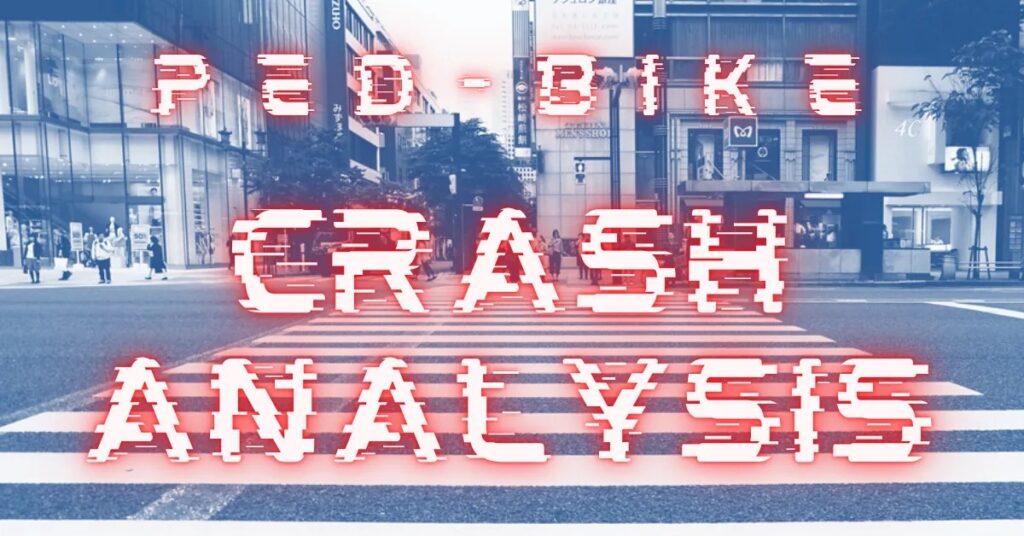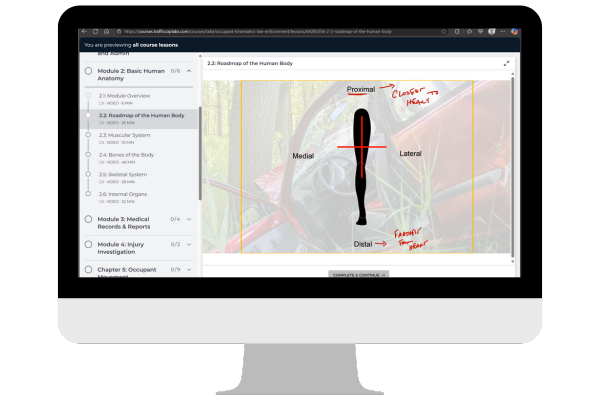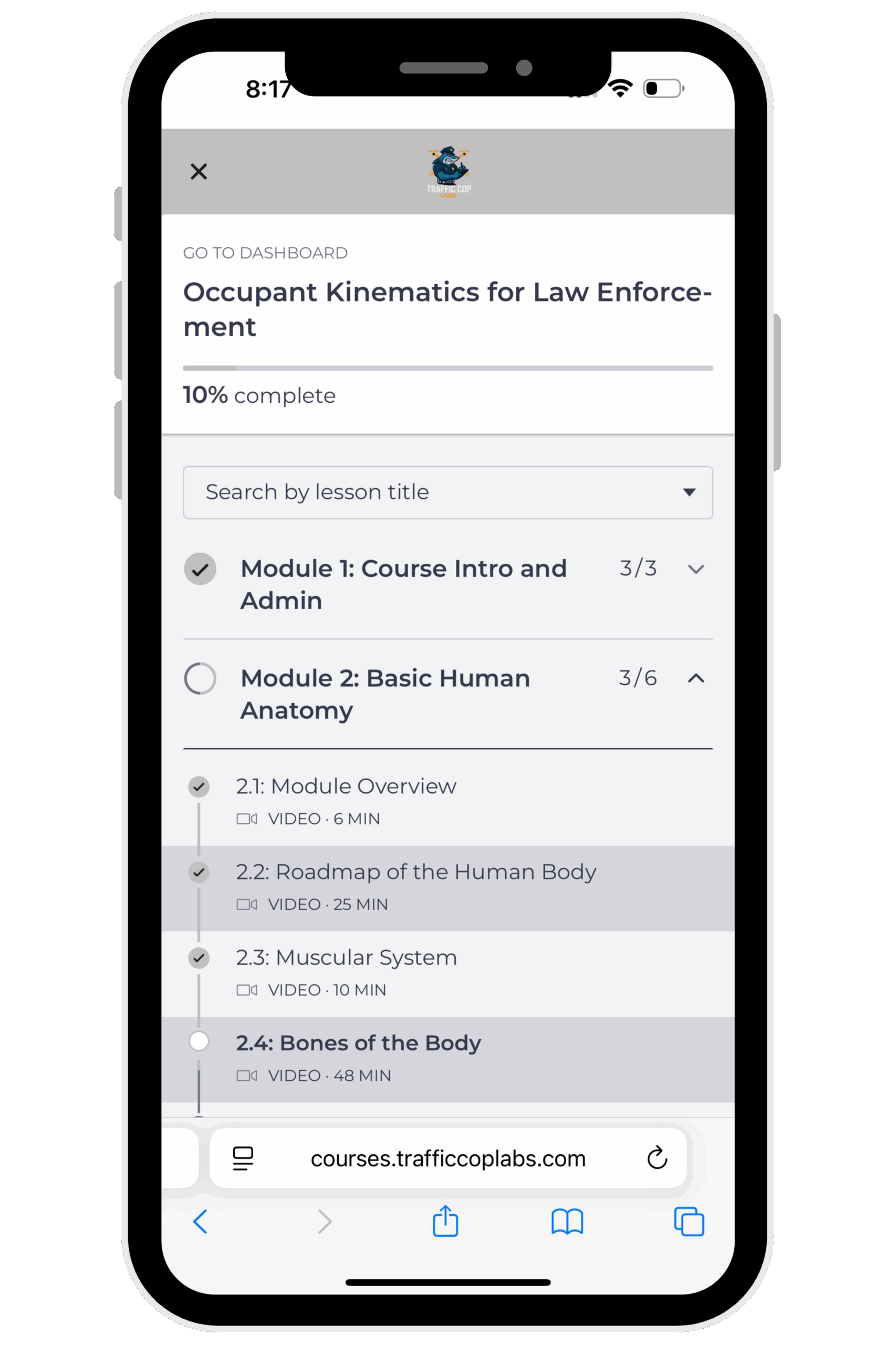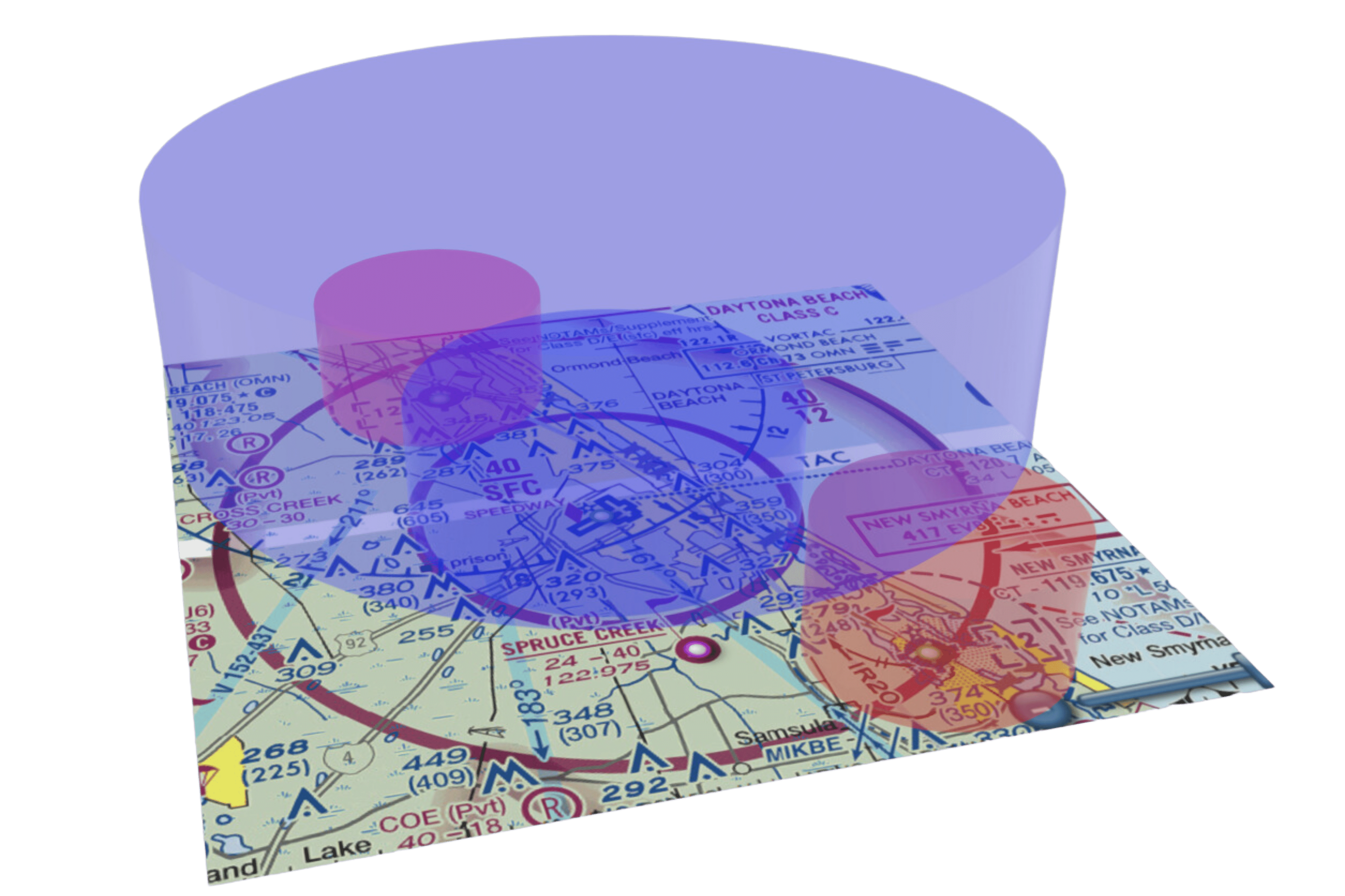Pedestrian-
Bicycle
Walk the Throw Path. Follow the Trajectory. Learn the Truth. Speak For the Victim.
Pedestrian and bicycle crashes leave more questions than answers. This course teaches you how to interpret the evidence—trajectory, injuries, damage, perception-reaction, and timing—to build a complete picture of what really happened, long after first impact.

What you'll learn
From environment and driver factors to trajectories, injury patterns, and final rest positions—we’ll teach you how to build a complete timeline of pedestrian and bicycle crashes.
You’ll learn how to apply and interpret formulas from Appel to Searle to Wood, with practice problems that help you understand—not just memorize.
Pedal velocity, lean angles, lateral acceleration—it’s not rocket science, but it is physics. We’ll break down what you need to know and how to use it.
Using time-distance analysis and walking/cycling speed data, you'll learn how to evaluate whether a crash could’ve been avoided—and support it with real numbers.
From photogrammetry to inverse camera methods, we’ll show you how to diagram and extract data from surveillance and dash cam video—without expensive software.
No theory without practice. You’ll work real case problems, analyze virtual crash tests, and walk away with experience you can actually use in reports and court.

No talking-head avatars. No AI-generated robot voiceovers. No lame video script. This training was built by actual instructors who’ve worked real scenes, not failed marketing interns. Every lesson is broken into short, focused videos you can actually finish before your next callout. And yes—most course add up to 15+ hours of legit, actionable content. Mix in real life case files and projects to make you think, not just take up time, and you're on your way to traffic guru.

In the station. On your phone. Between calls. This training works where you work. If you’ve got an internet connection, you’ve got access—no log-in times, no Zoom meetings, no BS. Whether you’re watching from a laptop, a tablet, or the MDT in your cruiser, you’re in control of your pace and your progress.

We ditched the dry lecture format and built something better. From 3D models to augmented reality tools and first-person views, our lessons use creative tech to lock it in. Projects just to take up space and time? Not here, if it's not from a real crash or test, it's not here. This isn’t just training—it’s a crash course in learning the smart way. Built for how you think. Designed to keep you moving.
Syllabus
Module 1
Get introduced to the course structure, core objectives, and background on pedestrian and bicycle crash statistics. We’ll cover administrative items and explore real-world safety trends that set the stage for deeper learning.
Module 2
Examine the contributing factors before impact ever occurs. This module analyzes the driver, the environment, and the vehicle itself—giving you a foundational understanding of how risk builds before the first contact. Includes a practical measurement assignment.
Module 3
In this module, we dive into what happens during the crash. You’ll learn how to read scene evidence, pinpoint impact locations, break down crash phases, and understand trajectory patterns. We’ll also introduce pedestrian dynamics and how they differ from vehicle-vehicle collisions.
Module 4
Learn how to analyze the results of a crash, including vehicle damage, injury patterns, and trauma scaling. Topics include basic human anatomy, blunt force trauma, and head injuries—all connected back to crash forces and movements. Wraps up with a review project to solidify what you’ve learned.
Module 5
Master the formulas used in pedestrian and bicycle speed estimates—including Appel, Barzelay, Bratten, Fugger & Randles, Limpert, Searle (1983 & 2009), and Wood. Each is paired with practical examples so you know when, why, and how to apply them. Bonus: you’ll also tackle quadratic equations and “no area of impact” situations.
Module 6
Understand the unique mechanics of bicycle crashes. This module covers bike nomenclature, pedal velocity, lean angles, and lateral acceleration—plus how these elements affect crash analysis and speed estimates. Includes a case-based example to tie it all together.
Module 7
Learn how to determine whether a crash was avoidable using perception-response times, walking/cycling speed studies, and time-distance formulas. You’ll practice evaluating driver and pedestrian behavior based on measurable, defendable data.
Module 8
Put theory into action with multiple pedestrian and bicycle crash scenarios. These real-world projects reinforce key skills in diagramming, speed estimation, and time-distance evaluation. Includes a dedicated walking speed study for added realism.
Module 9
Watch simulated crash tests and learn how to interpret their results. This module walks you through four virtual test cases and shows how test data connects back to your real-world investigations. Includes a results breakdown you can reference later.
Module 10
Learn how to extract meaningful data from surveillance, dash cam, or body-worn video. You’ll be introduced to photogrammetry, inverse camera techniques, and the step-by-step process for building a crash diagram using video evidence—even if you’re not a tech expert.
Your instructor

Bobby J. Mullinax is a former police officer and longtime crash reconstruction instructor who’s spent nearly the last two decades helping other investigators sharpen their craft. With 15 years in law enforcement and over 7,000 hours of instructional time, he’s taught agencies across the country how to turn chaos into clarity at the scene of a crash. He’s also the creator behind multiple training programs and tools built specifically for working reconstructionists — cutting through the clutter with real-world workflows, intuitive software, and plain-English instruction that actually sticks.
What students are saying
FAQs
Our course has a help module that includes a FAQ block as well as the process for contacting us for help. From explaining a question more thoroughly in an email to hopping on a Google Meet and walking through a project, we have several different avenues to assist you.
Since the course is available online, you'll be able to start the course when you register. Whether it's a Sunday at 2:00 AM or noon on a Thursday, you'll be ready to go.
It happens. If you buy this online course and within 30 days aren't 100% satisfied, we will refund your purchase price, minus a 3% administrative fee from our payment processor. We do reserve the right not to refund the course is more than 30% has been completed.
Instead of acting like we're haggling over an old stool at a flea market, we don't really discount registrations here. Instead, we offer true enterprise level training where you can license our training curriculum and enroll as many attendees from your business or public safety agency as you'd like. Contact us for more info.
